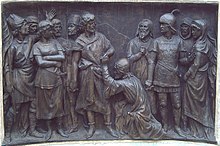
Back La vida es sueño Afrikaans La vida es sueño AN الحياة حلم Arabic La vida es sueño AST Life Is a Dream Azerbaijani Жыццё ёсць сон Byelorussian Животът е сън Bulgarian Život je san BS La vida es sueño Catalan ژیان خەونێکە CKB
| Life Is a Dream | |
|---|---|
 Detail from bronze relief on a monument to Calderón in Madrid, J. Figueras, 1878 | |
| Written by | Pedro Calderón de la Barca |
| Date premiered | 1635 |
| Original language | Spanish |
| Subject | Free will, fate, honor, power |
| Genre | Spanish Golden Age drama |
| Setting | Poland |
Life Is a Dream (Spanish: La vida es sueño [la ˈβiða es ˈsweɲo]) is a Spanish-language play by Pedro Calderón de la Barca. First published in 1636, in two different editions, the first in Madrid and a second one in Zaragoza. Don W. Cruickshank and a number of other critics believe that the play can be dated around 1630, thus making Calderón's most famous work a rather early composition.[1] It is a philosophical allegory regarding the human situation and the mystery of life.[2] The play has been described as "the supreme example of Spanish Golden Age drama".[3] The story focuses on the fictional Segismundo, Prince of Poland, who has been imprisoned in a tower by his father, King Basilio, following a dire prophecy that the prince would bring disaster to the country and death to the King. Basilio briefly frees Segismundo, but when the prince goes on a rampage, the king imprisons him again, persuading him that it was all a dream.
The play's central themes are the conflict between free will and fate, as well as restoring one's honor. It remains one of Calderón's best-known and most studied works, and was listed as one of the 40 greatest plays of all time in The Independent.[4] Other themes include dreams vs. reality and the conflict between father and son. The play has been adapted for other stage works, in film and as a novel.
- ^ Don W. Cruickshank, Don Pedro Calderon. Cambridge: Cambridge University Press, 2009, p.78
- ^ Brockett & Hildy, p.145
- ^ Racz, Gregary (2006), Pedro Calderón de la Barca: Life Is a Dream, Penguin, p. viii, ISBN 978-0-14-310482-7
- ^ "The 40 best plays to read before you die". The Independent. 18 August 2019. Archived from the original on 14 June 2022. Retrieved 8 June 2020.